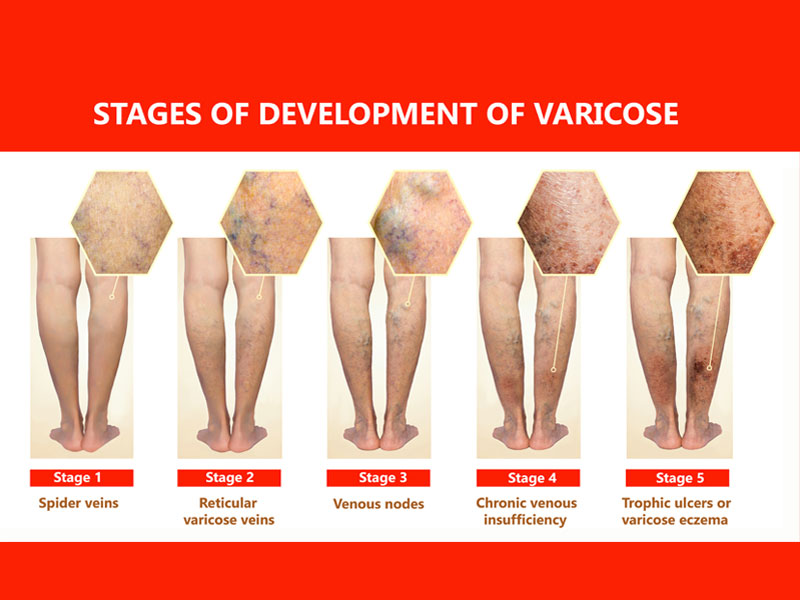
Vein removal treatment isn’t just for the cosmetically concerned. There are hidden health risks associated with untreated varicose veins that can cause discomfort and, if left untreated, lead to more significant issues. This article will cover the three primary reasons you should get your varicose veins treated, the stages of venous disease, and when you need to get yourself to a doctor.
Three Reasons to Consider Getting Treatment For Your Varicose Veins
1 Blood Clots and Varicose Veins
Potentially dangerous blood clots could be the underlying cause of varicose veins. Having your varicose veins mapped with a sonogram can uncover underlying deep vein thrombosis (DVT) and blood clots.
One study found that people with varicose veins are five times more likely to get deep vein thrombosis than those who don’t have varicose veins.
Why are blood clots bad? Because if they break off, they can travel through your bloodstream to your brain, where they can cause a pulmonary embolism. In the study we mentioned earlier, people with varicose veins experienced 793 cases of pulmonary embolism. Those without? Just 451 cases. That’s a significant difference. And an excellent reason to have a vein specialist take a closer look at what’s going on under your skin.
2 Varicose Vein Explosions
We know that the term “varicose vein explosions” sounds dramatic, but there’s no denying that when varicose veins burst, it isn’t a pretty picture.
Unfortunately, untreated varicose veins are under a lot of pressure. Eventually, the blood pooling up in the damaged vein needs somewhere else to go. That’s why varicose veins bulge up under your skin. Moreover, if the vein wall gets too weak and the pressure gets too high, the vein will burst. This may cause bruising, dizziness, or fainting.
The skin over an untreated varicose vein also thins out over time, which means that a burst vein may bleed out spontaneously. Not only is this a big mess, but it can result in a significant loss of blood.
If a vein bursts,
- apply pressure with a towel,
- elevate your legs, and
- seek medical help immediately.
3 Health Risks From Untreated Varicose Veins
Varicose veins affect more than just aesthetics. They aren’t just ugly ropy veins that you may want to hide away from prying eyes. They’re a medical condition and are popping up under your skin for a reason. The blood pooling up under your skin can cause a whole host of problems. These include:
- Your skin looking shiny and bruised and feeling waxy and thin.
- Your skin and the damaged veins feeling itchy.
- Cramping, sometimes even debilitating cramping, due to your blood not carrying enough oxygenated blood to certain areas.
- Leg ulcers and open sores that can expose your immune system to bacteria and infections, leading to further health complications.
- A blood clot possibly forming and causing Superficial Thrombophlebitis, leading to more damage or irritation.
- Stagnant blood flow in deep veins that can cause DVT (blood clots) and can lead to stroke or death.
In addition, varicose veins can be a symptom of lipodermatosclerosis, which leads to severe skin issues, and swelling. In some cases, surgery may be necessary.
Stages of Venous Disease
If you choose to live with untreated varicose veins, it’s essential that you can identify the stages of venous disease. With this knowledge, you’ll have a better chance of catching a change in your varicose veins or symptoms before it becomes a potentially harmful problem.
Venous disease occurs when the one-way valves that control blood flow through your veins become damaged. Valves in healthy veins open to allow blood to flow up towards the heart and then close so that the blood can’t slip backward. When these valves become weak or damaged, blood isn’t continuously pushed in a forward motion. Since it has nowhere else to go, the blood pools up, and the vein becomes enlarged, looking swollen and blue in appearance.
There are six stages of venous disease:
Stage one – spider veins. Small, reddish-purple veins (visible on the legs, ankles, neck, face, and other areas) aren’t typically problematic and are NOT covered by insurance.
Stage two – enlarged, ropy varicose veins. Not necessarily preceded by spider veins, this is the stage at which people often first become aware that they have vein disease and experience itching, burning, numbness, and weak or achy legs. Depending on the size of the veins (measured under ultrasound), sometimes insurance covers this.
Stage three – swelling without skin changes. At this stage, the body is no longer able to reabsorb fluid as well as it used to, causing swelling in the ankles and legs. Usually covered by insurance.
Stage four – skin changes and discoloration. Venous congestion and poor circulation leading to changes in skin color and texture. Usually covered by insurance.
Stage five – healed ulcerations. Toughened skin may become scratched or injured, leaving scars. Usually covered by insurance.
Stage six – active ulcers. In this final stage, injuries to the skin and leg ulcers will not heal, leaving your legs covered with bleeding, open sores. Insurance covers this.
When Should You Call a Doctor About Your Untreated Varicose Veins?
Obviously, you would prefer not to find yourself at stage six, so let’s talk about when to call a doctor about untreated varicose veins.
- Do you have severe and continuous pain and swelling in your legs?
- Do your legs feel heavy, dull, or achy at the end of the day or after physical activity?
- Do you suffer from restless legs?
- Are your varicose veins red and do they feel warm and tender to the touch?
- Are your varicose veins prone to bleeding on their own or due to injury?
- Is the skin around your varicose veins dry, itchy, discolored, and/or inflamed?
- Do you have open sores on your skin?
- Have you tried home remedies to alleviate varicose vein symptoms, but nothing is working?
- Are your symptoms affecting your daily life? Or limiting your activities?
Then it’s time to call a doctor or vein specialist!
Are you ready to have your varicose veins treated?
We’re Here to Help!
Denver Vein Treatment Center was built with you in mind. Our clinic has everything you need to get your varicose veins looked at, diagnosed, and treated under one roof. Dr. Norton has decades of experience treating varicose veins and uses the latest, minimally invasive vein-removal methods. Contact us for a consultation today!
